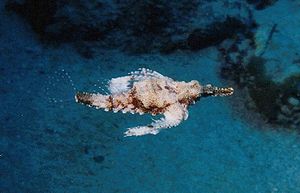Dwarf winged steed
| Dwarf winged steed | ||||||||||||
|---|---|---|---|---|---|---|---|---|---|---|---|---|

Dwarf winged steed ( Eurypegasus draconis ) |
||||||||||||
| Systematics | ||||||||||||
|
||||||||||||
| Scientific name | ||||||||||||
| Eurypegasus draconis | ||||||||||||
| ( Linnaeus , 1766) |
The Little Dragonfish ( Eurypegasus draconis ), also known as Little Wing Ross or Little Wing Dragon called, is a kind from the family of pegasidae (Pegasidae) and in the Red Sea and in the Indo-Pacific common.
features
The dwarf winged steed is seven to ten centimeters long. It has a conspicuous, elongated and tubular snout. Its body is rounded, provided with humped elevations on the back and clearly set off from the tail fin stalk. It is armored by three pairs of dorsolateral (on the sides of the back) and four pairs of ventrolateral (on the sides of the abdomen) bone plates. The caudal fin stalk is surrounded by eight, and in rare cases nine, bony rings. The hull is concave at the bottom. The bone ridges on the stomach are more pronounced than those on the back. They have teeth pointing sideways. There are deep pits behind the eye sockets. The eyes are not visible from above, but they are visible when viewed from below. The only dorsal fin sits on the caudal fin stalk and, like the anal fin, is supported by five soft fin rays. The fin spine and the first soft ray of the pelvic fins form a tentacle-like organ. The pectoral fins are fan-shaped and lined with blue or white. The color of the animals is in most cases light to dark brown, lighter on the belly than on the back. However, it can also vary greatly and be adapted to the respective substrate in a relatively short time. The vortex number is 19 to 22.
The males have a longer snout and a slimmer body than the females. The sexes do not differ in color.
distribution
The dwarf winged steed comes close to the ground at depths of 3 to 90 meters (mostly below 35 meters) in the Red Sea and in the Indo-Pacific from the coast of South and East Africa to Japan, Micronesia, the Marquesas and Society Islands , south to Australia and the Lord -Howe Island in front. In Hawaii it is replaced by its sister species , Eurypegasus papilio ( vicarious species ).
Way of life
The fish live in lagoons and estuaries on sand or silt soils, mostly near algae and sea grass meadows. They opportunistically feed on all kinds of small invertebrates , including worms and small crustaceans. Adult animals mostly live in pairs. They shed their skin at regular intervals by peeling off their skin in one piece. Dwarf wingfish spawn at dusk. The partners swim from the bottom into the open water and release their gametes . The eggs are planktonic .
literature
- Hans A. Baensch , Robert A. Patzner: Mergus Sea Water Atlas Volume 6. Non-Perciformes (non-perch-like) . Mergus-Verlag, Melle 1998 ISBN 3-88244-116-X
- Rudie H. Kuiter : Seahorses, pipefish, shredded fish and their relatives . Verlag Eugen Ulmer, Stuttgart 2001 ISBN 3-8001-3244-3
Web links
- Dwarf winged steed on Fishbase.org (English)
- Eurypegasus draconis inthe IUCN Red List of Threatened Species 2013.1. Posted by: Sorensen, M. & Vincent, A, 2010. Retrieved September 2, 2013.